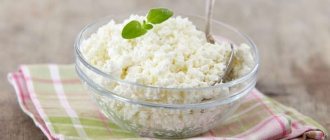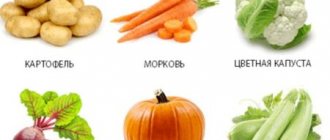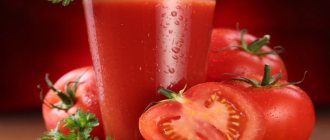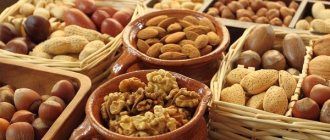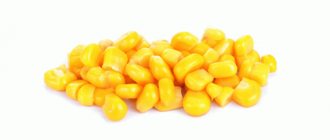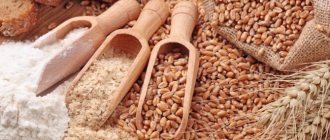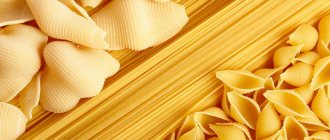Basic principles of therapeutic nutrition
It should be understood that regular consumption of certain foods leads to irritation of the inner lining of the stomach and promotes the growth of Helicobacter bacteria. Therefore, to achieve sustainable remission, adjusting the patient’s diet is extremely important.
Food entering the stomach must envelop its walls and protect them from excess hydrochloric acid. Nutrition should be complete and balanced. Following a diet will reduce the symptoms of the disease and achieve a speedy recovery. Food should be lean and low-calorie. It is important that its temperature fluctuates between 50-50 degrees. Food that is too hot or very cold will further irritate the inflamed stomach lining.
Meals should be fractional. You need to eat in small portions, but often. It is advisable that the interval between two meals does not exceed three hours. Such a nutritional system will reduce the load on the gastrointestinal tract. During the recovery period, it is necessary to abandon processed foods and fast food in favor of home-cooked dishes. It is useful to eat stewed vegetables, boiled porridges and pureed soups for gastritis. For drinks, it is better to drink jelly, compotes and herbal teas.
During an exacerbation of the disease, it is better to avoid fermented milk products, fried foods, lard, liver, fatty meat and fish. Canned food, smoked meats and sausages are also unacceptable during this period. Until stable remission is achieved, you should exclude melon, grapes, kiwi and citrus fruits from your diet. It is also undesirable to eat raw vegetables for gastritis. They contain a large amount of fiber, which mechanically damages the mucous membrane and aggravates the course of the disease. Nutritionists recommend caution when consuming dumplings, dumplings, pearl barley, peanuts, hazelnuts, almonds, chocolate, onions and garlic.
How to choose and prepare them correctly?
Today you can buy vegetables on supermarket shelves at any time of the year. You should choose only fresh, ripe fruits. If we are talking about squash or zucchini, you need to buy vegetables that are milky ripe, that is, young, with thin skin.
Seasonal plants are preferred as greenhouse tomatoes or cucumbers will contain too many nitrates. Imported products are treated with chemicals to maintain freshness and presentation.
Frozen foods are quite suitable for the diet because they retain all the benefits of fresh vegetables. In addition, it is quite difficult to purchase fresh green peas or corn.
Usually, raw vegetables are not recommended for gastritis. They can be introduced into the diet only after heat treatment.
- It is permissible to stew, blanch, boil, steam or bake vegetables without forming a crust.
- Before this, the rough shell must be removed. Oil is added after the dish is ready.
- It is best to serve vegetable soups or side dishes in the form of purees.
Vegetable dishes are necessary for the normal functioning of the intestines. The daily menu should include 3-4 servings measuring 100-150 grams.
Features of using vegetables
Plant foods are considered one of the most important components of the human diet. It helps to normalize the functioning of the gastrointestinal tract, which is especially important for gastritis.
Vegetables will help balance the patient’s menu and make it more complete. If the acidity level is high, it is advisable to consume them pureed, stewed, baked or boiled. Cauliflower, parsnips, potatoes, beets and carrots will be of particular benefit during the recovery period for a weakened body. During the season, you can supplement the patient’s diet with a small amount of fresh sweet tomatoes.
For gastritis with low acidity, vegetables should also be present in the diet. But you can eat them even raw. To reduce the load on the digestive tract, it is advisable to grate or chop them with a blender.
It is important to remember that in addition to the permitted list, there is also a list of prohibited vegetables. If you have gastritis, you should not eat cucumbers, spinach, onions, garlic, radishes and white cabbage. It is also necessary to exclude pickled, salted and canned vegetables from the diet of a person who has problems with the gastrointestinal tract.
The healing properties of broccoli for gastritis
In search of an answer to the question of which vegetables are recommended for consumption in atrophic gastritis, Japanese experts conducted an experiment. They wondered why Japanese residents are 6 times less likely to get stomach cancer than Americans. After all, among the Japanese there are many smokers and lovers of smoked and salty foods. Scientist Akinori Yunaka suggested that raw vegetables for erosive gastritis and some other forms can reduce the risk of tumor development. A detailed study of the diet of the average Japanese revealed that residents of the eastern country eat a lot of fresh vegetables and, in particular, broccoli.
Akinori Yunaka found 20 volunteers and asked them to eat 100 grams of fresh broccoli sprouts daily. It turns out that this vegetable is rich in an antioxidant with a very complex name: sulforaphane glucosinolate. The compound is notable for its ability to block carcinogenic substances that cause cancer.
After 2 months of daily consumption of broccoli, the concentration of Helicobacter Pylori in the stomach of absolutely all study participants decreased several times. The proportion of the enzyme pepsinogen, which indicates damage to the gastrointestinal mucosa, also decreased.
If you are interested in what vegetables you can eat during exacerbation of gastritis, look for the answer to the question from the wise Japanese. Fresh shoots of broccoli are a faithful assistant in the fight against gastrointestinal diseases.
Color matters
Of course, shade is not a fundamental factor for including a particular product in the diet. But it can be used to judge the beneficial properties of plant foods. Thus, yellow vegetables are rich in beta-carotene, which is recognized as an excellent natural antioxidant. In addition, this substance helps relieve inflammation of the mucous membrane of the digestive tract. Therefore, for gastritis, it is very useful to eat carrots, zucchini and pumpkin. During the period of remission, sweetish yellow tomatoes can be added to the patient’s diet.
But for gastritis, it is better to exclude red vegetables from your menu. Despite all their beneficial properties, they can irritate the inner walls of the stomach and can cause pain. You can safely eat only red potatoes and beets. But peppers, tomatoes and radishes are allowed to be consumed only after achieving stable remission.
As for green vegetables, they can be included in the patient’s diet only after preliminary heat treatment. This applies to artichokes, green beans and Brussels sprouts. The same goes for green onions and bell peppers. All of them in their raw form contribute to increased gas formation, and this is unacceptable for gastritis.
Stewed purple vegetables will also bring invaluable benefits to the human body. They contain a lot of useful substances, so it is advisable to periodically include them in the diet.
Features of the diet for acute forms of the disease
If an exacerbation of the disease occurs, then it would be reasonable to completely exclude all food for the patient for this period and give his digestive system a rest. In the event that the acute form of the disease is caused by poisoning or taking certain medications, you must first rinse the gastrointestinal tract and induce vomiting.
On the first day, drinking warm liquids and tea is recommended. The next day, if the patient's condition has improved, he can gradually begin the process of eating liquid food. First, it is recommended to consume liquid soups made from milk and cereals, meat and fish purees. Also allowed:
- weak tea,
- decoctions,
- jelly,
- honey.
In case of exacerbation, the following should be excluded from the diet:
- fresh vegetables and fruits,
- meat broths,
- dairy products,
- carbonated drinks,
- coffee,
- sweets,
- any bakery products,
- cheese.
All dishes should be steamed and served lukewarm. The calorie content of the diet should not exceed 2000 kcal.
When feeding patients with this type of disease, its characteristics should be taken into account. If gastric juice has low acidity, this means that food is not broken down well enough by it. Consequently, the body does not receive all the necessary components from food - proteins, fats and carbohydrates, vitamins.
The goal of the diet is to maximize the stimulation of the secretion of digestive enzymes and gastric juice. Unlike a diet for a disease with high acidity, in this case it is permissible to include fermented milk products, sour fruits and vegetables in the menu. Fried foods are also allowed to a limited extent, but only outside periods of exacerbation. The calorie content of the diet should be 2500-3000 kcal. Preference is given to semi-liquid and pureed dishes.
Nutrition for this form of the disease involves prohibiting fatty meats (pork), poultry (duck, goose), fish (salmon), and sweets. Also, you should not eat vegetables and fruits that cause fermentation - cabbage, onions, garlic, legumes, grapes.
White cabbage
Many people suffering from diseases of the digestive system often wonder if they can eat this vegetable. Experts do not recommend eating fresh cabbage if you have gastritis. It causes mechanical damage to the inflamed mucosa and increases pain.
However, this is not a reason to completely abandon this type of vegetable. For gastritis, stewed cabbage is indicated, which improves intestinal motility and saturates the body with useful vitamins and microelements. It is rich in sulfur, magnesium, potassium and iodine. Eating a small amount of sauerkraut will bring no less benefit for hypoacid gastritis. This product contains many pectins, which have anti-inflammatory properties.
Leafy
It is worth dwelling on leafy vegetables separately, since they often escape the attention of a patient with gastritis.
A person does not always pay attention to salad greens, chopped leaves with which a soup or side dish is sprinkled, considering them a neutral additive. However, they are complete food products that can cause both harm and benefit.
- Iceberg leaves are widely used in salads and snacks. The product stimulates parietal cells that synthesize hydrochloric acid. In case of hypoacid gastritis, you can safely eat it, but in case of hyperacid inflammation it is better to limit it. To neutralize its effect, it is better to season salads with low-fat sour cream, natural yogurt, olive or sea buckthorn oil.
- Arugula salad is useful for thyroid diseases due to its high iodine content. But the stomach does not “like” such salad leaves too much. They are too sharp and often cause irritation to the sensitive mucous membrane.
- Lettuce is rich in potassium, which is primarily necessary for adequate functioning of the heart and blood vessels. For gastritis, it is allowed because it is easily digested and has little effect on the acidity of gastric juice.
- Spinach is a unique vegetable in its composition. It is very nutritious and contains a large number of useful components. However, with hyperacid gastritis, it should be eaten extremely carefully and in small volumes, as it significantly increases acidity levels. It is safer to eat heat-treated spinach - it is added to soups, side dishes, and baked goods.
- Chard is a leaf beet, which in terms of the number of medicinal properties is not inferior to the root vegetable. This plant is quite safe for the stomach. Raw leaves only slightly reduce pH, and after heat treatment they become safe for any form of gastritis.
Potato
This is one of the healthiest vegetables. Its tubers contain a sufficient amount of water, starch, organic acids, fiber, iodine, magnesium and potassium. Therefore, both old and young potatoes should be present in the diet of people suffering from gastritis. Regular use of this product helps normalize the functioning of the stomach and intestines. Therefore, it is included in all therapeutic diets.
Potato juice is of particular value in the treatment of gastritis. It is he who is recognized as one of the most effective folk remedies that help get rid of problems with the digestive system. It is squeezed from fresh peeled tubers of old or young potatoes and drunk half a glass before meals.
This root vegetable is no less useful when boiled or baked. With proper heat treatment, it retains the bulk of valuable vitamins and minerals. The only thing that is unacceptable for gastritis is fried potatoes. It is believed that it creates excessive stress on the digestive tract and injures the mucous membrane.
Benefits of eating vegetables
The benefits of vegetables are widely known. Fruits contain a lot of essential substances that are necessary to maintain human health. Firstly, these are a variety of vitamins. Secondly - minerals, thirdly - fiber.
Healthy people are recommended to consume at least 500 grams. vegetables a day. This portion allows you to provide the body with the necessary nutrients.
Carrot
This is another striking example of healthy vegetables. For gastritis of the stomach, stewed or steamed carrots are recommended. It helps eliminate vitamin deficiency, heal ulcers, relieve spasms and improve metabolism. In addition, carrots accelerate the regeneration process of damaged mucous membranes and eliminate inflammation of the stomach.
Despite all its benefits, experts do not recommend consuming it fresh or fried. And for gastritis with a high level of acidity, drinking carrot juice is contraindicated.
Broccoli against bacteria
Although we wrote above that vegetables from the “green” group should be consumed with caution, there is an exception to this rule. So, according to an article published in the Japan Times in November 2005, eating broccoli for gastritis is not only possible, but also necessary.
A diet rich in sulforaphane glucosinolate stimulates the production of antioxidant enzymes in the mucous membrane. In this way, the patient is protected from damage caused by Helicobacter pylori and is less vulnerable to gastritis and stomach cancer.
The author of the material, Akinori Yanaka from the University of Tsukuba, conducted an interesting experiment that clearly demonstrated whether broccoli is good for gastritis. He assembled a test group of 48 men and women and then divided it into two. The first subgroup ate about 100 g of three-day-old broccoli shoots daily, the second - an equivalent volume of alfalfa shoots.
The experiment lasted for two months, during which the subjects underwent basic tests: respiratory, serum and stool analysis. Those who ate alfalfa performed about the same at the end of week 8 as before the start of the trial.
But for those who consumed broccoli for gastritis with high acidity, the results improved significantly. The level of Helicobacter pylori (a gram-negative spiral-shaped bacterium that occupies a leading position in the etiology of chronic gastritis) in their bodies was significantly reduced.
However, as further testing has shown, the results of such a diet are short-lived. After returning to a normal diet, the subjects, within 2 months, again reached the same infection rates as they had before testing began.
Therefore, it is impossible to say that broccoli for gastritis with high acidity is a universal medicine. To obtain a stable result, patients will have to eat this vegetable regularly throughout the rest of their lives.
It was not by chance that scientists chose young shoots for the experiment. On the 2-3rd day of growth, the maximum amount of sulforaphane accumulates in broccoli: approximately 250 mg per 100 g of plant.
bell pepper
This is quite a useful, but at the same time controversial product. Experts advise treating it with extreme caution. The substances it contains act on the inner walls of the stomach and change the concentration of hydrochloric acid produced.
In addition, bell peppers contain quite a lot of poorly digestible fiber. Nutritionists recommend occasionally including baked yellow vegetables in the diet for gastritis. Before consuming these peppers, it is advisable to peel them.
Benefits and harms
Vegetables are the main supplier of vitamins and fiber .
They contain carbohydrates, polysaccharides, minerals, and organic acids. Regular consumption of vegetables helps in proper digestion. Essential oils contained in some vegetable crops stimulate the appetite. Dietary fiber improves intestinal motility , adsorbs toxins, and promotes the removal of excess fluid.
Fiber helps process and absorb heavier protein foods such as meat or fish. With a low calorie content, vegetable dishes create a feeling of fullness for a long time.
The benefits of vegetables can be easily determined by their color . Beta-carotene gives the orange or yellow color. This antioxidant will protect the mucous membrane from erosions and ulcers. Red vegetables help prevent cancer.
Expert opinion
Irina Vasilievna
Practicing gastroenterologist
It is preferable to eat red potatoes or beets for gastritis. Bell peppers, radishes, or cabbage cause gas and are considered gross foods, so they are best avoided.
Green vegetables are rich in iron, so they are indispensable for anemia, which is a frequent companion to erosive or atrophic gastritis and ulcers. Varieties of potatoes, onions, and carrots that are purple in color are good for the heart and blood vessels .
We should not forget that the benefits of the product are determined by the characteristics of the human body and the presence of chronic ailments.
- For example, table beets are contraindicated for kidney stones;
- garlic will provoke a painful attack of ulcers or gastritis.
Coarse fiber, which vegetables are so rich in, can be dangerous for gastrointestinal diseases.
Therefore, the list of products acceptable for consumption in one case or another will be different for everyone . We have a whole separate section about restrictions on fruit consumption, take a look at it and you will learn a lot of new things.
Additional recommendations
However, vegetables for stomach ulcers and gastritis are partially allowed in the patient’s diet. It is important, of course, to observe moderation and follow the rules below.
- It is advisable to heat-treat vegetables before consumption, since in their raw form they can cause flatulence. Dietary dishes and salads that contain permitted vegetables and herbs are allowed for gastritis.
- Stewing is also an effective processing method, after which vegetables are comfortably digested. This will ease the work of an irritated stomach.
- Steamed vegetables can not only be easily absorbed and digested, but also deliver all the stored vitamins and minerals to the body. For patients with gastritis and ulcers, having a steamer is a good help in curing the disease.
- Home technical assistants also include a blender and a juicer - this equipment can do half the work of the stomach, which requires rest.
- While eating, also try to chew your food finely to ease the work of your stomach. It is prohibited to consume fried, highly seasoned foods and vegetables. You should also not eat pickled or sour vegetables. During an exacerbation, it is necessary to follow a diet in which these foods are strictly prohibited.
- For successful treatment, it is not enough to adhere to just a diet, although this is also important. It is recommended to undergo a course of medication together with a gastroenterologist. Dual focus in this process will be the key to the patient’s recovery.
- In addition, we recommend monitoring your daily habits. Thus, stress and nervous tension are the main causes of gastritis and ulcers. Monitor your psychological state and do not allow problems to control your mood. In addition, the result of nervous breakdowns can be much more serious diseases than gastritis and stomach ulcers.
With gastritis and ulcers, as you know, you need to strictly monitor your diet. A gastroenterologist will help you create a suitable menu. Among the variety of products, the doctor will highlight those that will not harm the stomach and will make the process of eating more enjoyable and the stage of digestion of food painless. Don't be lazy and visit a doctor. In addition, a “colored cheat sheet” can help in choosing products, in which vegetables are divided by color and permitted and prohibited foods are indicated.

